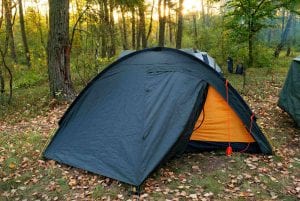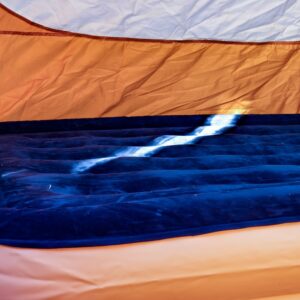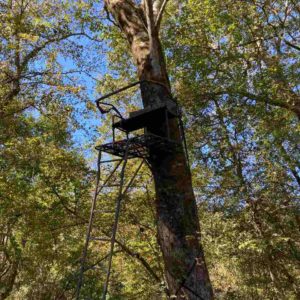When I was a student I had a beast of a tent but some of my friends had these incredible, super-lightweight, 1-person numbers. It only ever took a few miles of hiking to make me very jealous of them but it wasn’t until I did my first solo backpacking trip that I actually invested in one myself.
Now, years later, I’ve used loads of them and I thought it would be useful for me to shortlist my opinion of best 1 person tents currently available to help others choose from the huge range on offer.
Alps Mountaineering Zephyr 1 Review – Best One Person Tent

Specs
The Zephyr 1 has a free-standing, 2-pole design. Its minimum weight is 3lbs 10oz and it has a max weight of 4lbs 5oz. It has two doors and one vestibule for storage. The walls are all made of mesh and the separate rain fly is well-waterproofed. It has a good number of mesh pockets and a storage loft. ($$$)
The Verdict
Look, this isn’t an ultralight option like the Copper Spur UL1, but it is a phenomenal all-rounder at a fantastic price point. I think it’s the best 1 person tent on the market because it has the best blend of features without breaking the bank.
I love the fact you can just use the fly net for star-gazing and even with the rain fly on it means you’ve got great ventilation. Some people say they’ve experienced some condensation in the mornings but I didn’t think it was bad at all; certainly better than many other tents I’ve tested.
As mentioned already it is a bit heavier than some people would like and it’s also a bit bulkier than other one man tents. But it also has great storage space. And in the end all this comes down to personal choice. I understand the appeal of shaving ounces and cubic inches from a pack, but the reality is it ain’t gonna make or break a trip. The Zephyr is spacious, comfortable and weather-resistant. It comes in at sub-$200. And I think for more people, that’s an excellent deal.
My only gripe is the floor could be more durable and it doesn’t come with a footprint. But you can buy that separately and it’s not very expensive (check it out here). Worth considering if you plan on pitching over tough ground or if you just want to extend the life of the tent.
In Summary…
This lightweight tent is an awesome choice for backpacking, thru-hiking, bikepacking or any other type of solo camping. It’s not going to break the bank or your back. It is going to keep you dry and will last for years. If you need something lighter and higher spec, buy the Big Agnes Copper Spur HV UL1 instead.
(Incidentally, if you’re looking for a slightly cheaper option, Alps Mountaineering also do the Lynx 1. You can read my review here or check it out on Amazon here. It’s a nice tent if the Zephyr is out of your price range but as backpacking tents go, I think the Zephyr 1 has a nicer design and better build quality so well worth the extra few dollars).
Big Agnes Copper Spur HV UL1 Review – Best 1 Person Backpacking Tent

Specs
The Big Agnes Copper Spur HV UL1 has a trail weight of 2lbs 2oz and a max weight of 2lbs 8oz. It boasts more than 3′ of head room and 20 square feet of floor space (it’s a bathtub floor). For storage you’re looking at loads of interior pockets, a media pocket and a massive gear loft. It packs down to just 4″ x 16.5″. ($$$$)
The Verdict
The Copper Spur UL1 is widely considered to be the very best one man tent for backpacking on the market. This is in large part because of Big Anges dedicating themselves to providing kit that is extremely light and packable without compromising on comfort. The result is you get a helluva space at the same time as trimming ounces from your pack.
If that sounds too good to be true then you do need to bare in mind that all this comes at a price. This ain’t a cheap tent by any stretch of the imagination. But it is beautiful, extremely well designed and could well be the only single person tent you ever need to buy. If you are the sort of person who buys into the old adage of “buy cheap pay twice” and you want to invest in a tent for life, the Copper Spur has to be in the running for your hard-earned dollars.
In Summary…
This is a great choice if you’re looking for a super lightweight tent that packs up small whilst also providing a large living space. Honestly this ultralight tent really is one of the best backpacking tents on the market today.
If you think you’re only going to use a tent a couple of times a year, you may want to look at a different option because Big Agnes is a serious tent that deserves to be in the back country as much as possible!
Alternatives
The MSR hubba nx is another really good light weight tent. And it’s 4 seasons! So worth having on your radar… (Check out the reviews on Amazon)
Also the Nemo Hornet is another extremely high quality tent worth thinking about in this class. (Again, worth reading the reviews…)
Ozark Trail 1 Person Backpacking Tent – Best Cheap One Person Tent

Specs
Rated for 3 seasons and weighing 4.4lbs, the Ozark Trail 1 Person Backpacking Tent also comes with a gear loft, a couple of mesh pockets and an e-port for an electrical extension cord. ($)
The Verdict
This Ozark Trail 1 is very much at the opposite end of the spectrum from Big Agnes and manages to be both extremely cheap whilst providing lots of space and a reasonable degree of durability. There is enough room that you might consider it a 1.5 person tent. It is easy to set-up and take-down. And it’s far more solid than you might give it credit for given the low, low price point.
It is not a lightweight tent. Indeed, it’s quite heavy for a one man tent (you’ll probably notice the weight after hiking a few miles). And it’s also bulkier than other solo tents when packed. And look, the presence of an e-port for electricity suggests it’s not really intended for much use in the backcountry.
However, it is perfectly serviceable. If budget is the only thing holding you back from an awesome backpacking expedition, then all you really need to do is give it a bit of extra waterproofing, some different tent stakes and away you go!
In Summary…
When it comes to quality backpacking tents, you usually expect to pay a lot of money. But this is a great choice if you’re looking for a cheap one person tent. If money is the only thing standing between you and a camping trip, just get it!
Geertop 1 Person Tent Review – Best Ultralight 1 Person Tent

Specs
The Geertop 1 has a couple of configurations. It’s available as a mesh inner tent only, a rainfly only or a combination of the two. Depending on what you go for you get a certain number of stakes and guy ropes. All options come with a carry bag and tent stakes (but no tent poles, because you use your trekking poles instead. The rain fly weighs less than 2lbs and the inner tent weighs less than 1lb. It’s rated for 3 seasons. ($$)
The Verdict
It’s very unusual to find a tent that is both ultralight and easy on the wallet but the Geertop 20D achieves both those things! It packs down extremely well. With two doors and two ventilation windows, condensation is absolutely not a problem. And it even has two vestibules, providing more than enough storage for your gear. The flysheet and inner tent can be used separately which is an added bonus.
So what’s the catch? Well, it doesn’t come with poles. The intention here is to provide a low-cost, ultralight tent for thru-hiking and the designers figured that most people doing that would also carry trekking poles. So to strip away weight, they ditched the tent poles and suggested your trekking poles can be used instead. Pretty smart, eh?!
I did have a few niggles. If you’re over 6-feet tall you might struggle to fit comfortably. The stakes are the standard ones you get with most backpacking tents and given that the tension of the tent really relies on staking it out well, you may want to upgrade to some better ones. And the zippers are flimsy (although if you fashion some zip-pulls out of paracord, that definitely helps).
But other than those minor complaints, what you’re left with is a very innovative design and a very sturdy, extremely practical, high quality, ultralight shelter for a remarkably low cost.
In Summary…
If you’re looking for a lightweight one man tent suitable for thru-hiking which doesn’t break the bank, this is a great choice! It’s not the easiest to set up and you’ll definitely need some trekking poles. You can also pimp it out a bit by upgrading your tent stakes and some and fashioning some zip pulls from paracord.
If you’re over 6-foot, you might want to look at a different option (the Snugpak Ionosphere could be a great alternative for you). But for anyone under 6-foot it’s really great value, very comfortable and will last a very long time.
Snugpak Ionosphere 1 Person Tent Review – Fantastic Lightweight Solo Tent

Specs
The Snugpak Ionosphere weighs just 2.5lbs. It’s a low profile tent with a single door. The floor space is 24 square feet (8’x3′.)
The Verdict
The first thing to say about this tent is that it’s a firm favourite with military personnel. And they have good reason to like it! It’s an unobstrusive, lightweight tent that’s also extremely robust. And it’s easy to set up. If you want a small tent that does the job and isn’t going to let you down, this is it.
You’re not going to be able to sit up in it. But there’s plenty of room for a single person to stretch out and still have enough storage space to stow their gear. Two people could squeeze in if you were in a tight spot. So that gives you an indication of size. I do know people who’ve been able to fit their dog in with them without being uncomfortable.
If you want a flashy tent, don’t even think about buying this one! Everything about it is the opposite of flashy. This is a tent for no-nonsense people. Bikepacking or kayaking? Take a serious look. Scouts? Hunting? Backpacking? Yes, yes and yes. A very high quality piece of kit.
In Summary…
This is a practical tent for practical people and is therefore an excellent backpacking tent. Any sort of multi-night trip, especially moving camp from night to night, would benefit from this piece of kit.
Snugpak Ionosphere Alternative


If you’re looking for an interesting alternative to the Snugpak Ionosphere for any reason, do take a look at the Winterial Single Bivy Tent. At 3.3lbs it’s about 50% heavier than the Ionosphere but it has the same low profile design, approximately the same dimensions (same height but about 6″ shorter and 2″ wider) and a fair bit cheaper. You can check it out on Amazon here…
Luxe Tempo 1 Person Tent Review – Best 1 Person 4 Season Tent

Specs
The Luxe Tempo 1 is rated for 4 seasons, weighs 4lbs and comes with a footprint included in the price. It also has 2 vestibules for gear storage. The loops and guylines are reflective. ($$)
The Verdict
Regular readers will know that I don’t always recommend the most obvious gear. This is one example (because the MSR Hubba NX has a better technical spec IMO). But the Luxe Tempo 1 offers a tremendous balance of features at a great price point which is why it tops my list of best 1 person tents.
A lot of one man tents can be quite cramped but with the Luxe Tempo you buy yourself a really good amount of space; both living space and gear storage. You can sit up inside and there are two vestibules that will keep all your gear bone-dry. It stands up to most weather, including heavy rainfall and big winds. It’s easy to set up and break down. And it comes with a footprint, which is a nice touch.
It’s a bit on the heavy-side as one-person tents go. And the fact it’s a four season tent means that the ventilation may be a bit limiting for summer camping in hot climates. (But hey, you can always flynet!). Other than that, I can’t really fault it.
In Summary…
If you’re looking for a great all-rounder and you likegood quality and great value, this is a fantastic choice. It’s not the lightest tent on the market, or the most compact. But it’s well-designed, useful in a range of seasons and environments, and won’t break the bank.
Alternatives
The MSR Hubba NX is a lovely tent. Slightly higher quality. And more expensive. But lovely nonetheless.
How to Choose the Best One Person Tent
Most one person tents are designed with one thing in mind: portability. And so it will come as little surprise to hear that the most popular one person tents are the lightest and most compact.
But those are the only features worth paying attention to if you want to buy a truly great backpacking tent. Here’s what we believe you should be looking at:
- Weight
- Packed Size
- Interior Space (floor space and peak height)
- Vestibule Space
- Price
Weight
One person tents usually weigh significantly less than 4lbs. The best solo backpacking tents will weigh less than 2lbs. While the best budget one person tents are usually in the 3 – 3.5 lb range. Most mid-range backpacking tents weigh between 2lbs and 3lbs.
The lightest tent in this article is the Nemo Hornet 1 with a trail weight of just 1lb 10oz while the heaviest is the MSR Elixir 1 at 3lbs 15oz.
Somewhat surprisingly, the Hornet offers more than 22 sq feet of floor space compared to the Elixir’s 20 sq ft. In fact, the two tents have remarkably similar specs with the exception of the vestibule space where the Elixir’s 12sq ft beats the pants off the Hornet’s 7.
So what affects weight when it comes to one person tents?
Space – Obviously the smaller a tent is, the less material it uses and so you’d expect to see some weight savings. While most one person tents provide around 20sq feet of internal space, one of the areas many ultralight tents cut back on is the size of the vestibule.
Materials – Simply put, the more technical the tent fabric, the lighter (and more expensive!) your solo tent will be (as per the Elixir vs Hornet example above). A budget tent will use cheaper, heavier materials.
Trail Weight vs Packed Weight
The packed weight takes all of the components into consideration; the inner tent, poles, pole bag, rainfly, stakes, stuff sack, instructions, and more.
The trail weight consists of the minimum equipment you will carry to set up the tent. This would include the tent poles, rain fly, and inner tent body.
All of the comparison’s made in this article refer to trail weight.
Packed Size
The best one man tent for backpacking will not be too bulky. The reality is that there isn’t a huge amount of variation in packed size when it comes to one person tents. But it’s worth looking at simply because packability is often over-looked in favor of weight savings.
Most one person tents come in a stuff sack that’s between 15″ and 20″ long and a diameter of 4″ to 7″.
Measured in litres, one person tents range from around 3.5l up to 10.5l. One of the reasons some people reckon the Sea to Summit Alto TR1 is the best 1P tent is because at 2lbs 1oz it’s one of the lightest tents on the market AND, with packed dimensions of 18″ x 4″ (just 3.55 litres), it is also possibly the most compact solo tent you can buy.
Interior Space
Most one person backpacking tents have an interior space of between 18 sq feet and 23 sq feet.
When it comes to peak height you there’s much more variation in solo tents with a range from 28″ all the way up to 42.5″.
The best solo tents for backpacking manage to provide quite a lot of space without carrying a serious weight penalty. Again, the Sea to Summit Alto TR1 is a great example lightweight tents that offer amazing headroom (over 42″) and very reasonable living space (20 sq feet).
Some people might prefer a low profile tent, of course, which is where the likes of the Snugpack Ionosphere (30″ peak height) and the Eureka Solitaire (28″ peak height) come in. But for the average backpacking trip a roomy interior space is likely to be a bonus.
Vestibule Space & Other Storage
The best solo camping tent is going to provide ample gear storage. Because without an ample gear storage area you are going to have to bunk with your kit. Most lightweight tents have at least just enough space for extra gear storage by way of a vestibule. But other tents (like the Eureka Solitaire) do not.
Most one person tents have a vestibule with between 6sq feet and 9sq feet of space. The ALPS Mountaineering Lynx 1 and MSR Elixir 1 are exceptions offering 10 sq feet and 12 sq feet respectively.
Look for decent gear storage. Some of the more basic designs will save on gear storage but the higher quality models should have useful bells and whistles to help you organise your tent.
Price
The best ultralight one person tent is probably going to run you $400 – $500 (although the Big Agnes Tiger Wall UL1 and the Nemo Hornet 1 both have RRPs of less than $400).
The best budget one person backpacking tent is probably the Kelty Late Start 1 which most retailers price at around $140. And if you’re willing to accept the weight penalty (usually over 3lbs) then you can find several more great 1P backpacking tents for less than $200.
If you want a 4 season backpacking tent, however, you’re going to need quite deep pockets. The cheapest all season one person tent is likely to set you back at least $550 and the best of them may even stretch to the $1,000-mark.
Three-Season and Four-Season Tents
Three-season tents are the most popular choice. They are designed to handle the milder conditions of spring, summer, and fall. They can handle stronger winds, but do not do well with snow loads. They have mesh panels to aid in airflow and to keep bugs out. These tents usually have walls that are more vertical to give extra headroom, and they weigh less due to light weight fabric and fewer poles. Always check in the reviews if the tent can really manage all 3 seasons.
Four-season tents are designed to handle stronger winds and snow loads. They usually have a lower profile with a better quality rain fly and rounded dome designs. They have fewer mesh panels and are made from heavier fabric that offers less ventilation. They will use more poles in order to offer a more sturdy design. All of this added protection comes at the price of more weight.
FAQs
How Much Should a Backpacking Tent Weigh?
A backpacking tent should weigh as much as you’re willing to carry! That said, most backpacking tents weigh between 2lbs and 4lbs. Some, like the Big Agnes Tiger Wall UL1 weigh less than 2lbs. Be aware that the lightest tents can be really small and/or really expensive, so you need to balance that against weight savings.
How Much Is a 1 Person Tent?
A 1 person tent typically costs between $150 and $500 for a 3 season tent. A good 1 person, 4 season tent can cost anywhere between $500 and $1,000.
Is a 1 Person Tent Worth It?
A one person tent is definitely worth it for solo backpacking or bikepacking. Some people feel that going bigger makes for a more versatile tent. But for solo travel, the weight and compactness of a 1 person tent is definitely worth it.
How Big of a Tent Do I Need for One Person?
Dimensions for one person tents are around 84″ – 94″ long, 30″ – 40″ wide and 28″ – 42″ high. Don’t forget about vestibule space if you want gear storage. The Nemo Hornet 1 is a great example of a well-proportioned 1P tent.
What Are Single Person Tents Called?
Single person tents are generally called one person tents, or solo tents, or backpacking tents or single person tents. You can also get bivvy-style tents and tarps but there are not strictly single person tents.
What Is the Lightest 1 Man Tent?
The lightest 1 man tent is the Nemo Hornet 1 which has a trail weight of 1lb 10oz. It is possible to go lighter if you only camp with a fly net or a tarp. But when it comes to lightweight tents, the Hornet 1 is the lightest we could find.
Further Reading
Don’t forget, a one man tent isn’t for everyone. If you are looking for something more social, do check out my reviews of the best 3 person tents. Alternatively, if you want to get even more light weight, check out my reviews of the best tarps for camping and the best hammock tarps.





